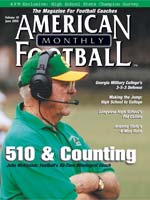AMERICAN FOOTBALL MONTHLY THE #1 RESOURCE FOR FOOTBALL COACHES
Article CategoriesAFM Magazine
|
Maximizing Player PerformanceHeat-related illness prevention in footballby: AFM Editorial Staff © More from this issue Coaches don’t need as much reminding these days. The summer of 2001 brought heat-related football illnesses to the forefront. The death of the Minnesota Vikings’ Korey Stringer in 2001 brought a rash of media attention to the issue of staying cool during football training camp. It was indicative of a larger issue – from 1960 to 1998, there have been 91 documented heatstroke deaths related to football. When the story became national news, coaches took notice. Today, focus on heat-related illness in football is at its highest level ever. “Kids and professionals have died from this – this is serious,” said Larry Kenney, Ph.D., professor of physiology and kinesiology at Penn State. “A smart coach will realize that it’s not just college and pro players who is at risk.” S....The full article can only be seen by subscribers. Subscribe today!
|
|
|||||||
| HOME |
MAGAZINE |
SUBSCRIBE | ONLINE COLUMNISTS | COACHING VIDEOS |
Copyright 2025, AmericanFootballMonthly.com
All Rights Reserved





